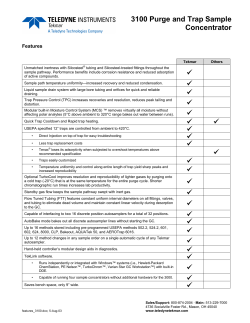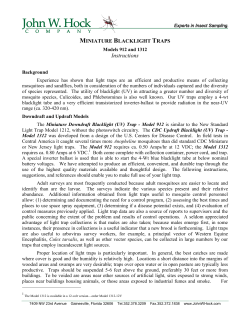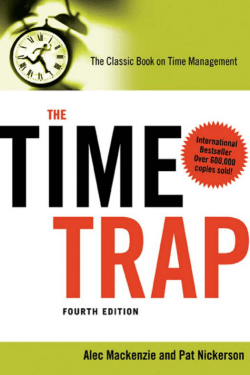
Dasineura oxycoccana Abstract
Blueberry gall midge (Dasineura oxycoccana Johnson) monitoring in rabbiteye blueberries in Florida E. M. Rhodes and O. E. Liburd Entomology and Nematology Department, University of Florida Abstract Materials and Methods Blueberry gall midge (BGM), Dasineura oxycoccana Johnson, is a pest of blueberries throughout North America. Monitoring for adult emergence is critical for timing insecticide applications. Emergence and panel traps are both effective monitoring tools for BGM. The objective of this study was to determine if clear sticky sheets were at least as effective as panel traps in monitoring BGM adults. A RCBD design with four replicates of four treatments was set up at an organic rabbiteye blueberry farm in Gainesville, FL. Treatments included the clear sticky sheet, panel trap, bucket emergence trap, and an unfolded yellow sticky trap (control). Panel traps and clear sticky sheets caught similar numbers of midges. Bucket traps caught the highest numbers of midges and yellow sticky traps caught no midges. The BGM population was too small for any of the differences to be statistically significant. • RCBD with 4 replicates of 4 treatments (fig. 3): a) bucket emergence trap, b) panel trap, c) clear plastic sheet trap, and d) yellow sticky trap hung unfolded • Traps were spaced ~ 15 m apart and rotated each week to avoid positional bias from 21 Jan to 11 Mar 2014 • Traps were replaced each week and the number of BGM adults were counted back at the Small Fruit and vegetable IPM laboratory in Gainesville • Bud samples were also collected each week to monitor larval populations (Rhodes et al. 2014) • Midge populations were low and the data could not be normalized even with transformation, so a Friedman, Kendall-Babington Smith nonparametric test was used to compare midge adults per trap among treatments summed over the whole sampling period Introduction a c Conclusions 2.5 2 • Clear sticky sheets caught similar numbers of midges to panel traps, so further testing should be done on this trap 1.5 bucket panel clear yellow buds 1 Future Research • The experiment needs to be repeated in an area with higher midge populations • A study looking at the effects of trap height on midge catch with the clear sticky sheets 0.5 0 21-Jan 28-Jan 4-Feb 11-Feb 18-Feb Sampling Date 25-Feb 4-Mar 11-Mar Fig. 5. Average BGM adults per trap and larvae per bud (green line) each week • Getting the traps out early enough to compare the time of first catch Acknowledgements Our thanks to the Gainesville Blueberry Farm where this research was conducted . Thanks also to Dr. Nicole Benda for assistance with field sampling. 5 b References Average midge per trap 4.5 4 Cook. 2011. Dasineura oxycoccana (Diptera: Cecidomyiidae) populations. M.S. thesis. Simon Fraser University. 3.5 Fig. 2 3 Lyrene and Payne. 1992. Blueberry gall midge: a new pest. Proc. Fla. State Hortic. Soc. 105: 297-300. 2.5 2 Rhodes, E. M et al. 2014. Field Distribution of Dasineura oxycoccana. J. Econ. Entomol. 107: 310-318. 1.5 a d • No midges were caught on yellow sticky traps hung unfolded, so they are not an effective monitoring tool Fig. 1 a b Results Average BGM per trap or per bud Blueberry gall midge is a pest of cultivated blueberries throughout North America (Sampson et al. 2006; Steck et al. 2000). Pupae overwinter in the soil, emerging adults (fig 1a) mate, and then females lay eggs in developing flower and leaf buds. Larvae (fig. 1b) develop in and feed on the buds causing injury that prevents leaves (fig. 2a) and flowers (fig. 2b) from developing. High infestations in leaf buds can lead to a reduction in flower buds the following year (Steck et al. 2000). High infestations in rabbiteye blueberry flowers can result in yield losses up to 80% (Lyrene and Payne 1992). Monitoring is key to targeting adult BGM emergence peaks with insecticide applications. Roubos and Liburd (2010) determined that a bucket emergence trap is effective in Florida while Cook (2011) successfully employed a 30 x 30 cm panel trap in Canada. Rhodes et al. 2014 determined that the panel trap works in Florida, but is not as effective as the bucket trap. A clear sticky sheet would be much easier to use and mass produce than the panel trap and could prove more efficacious as the height can be adjusted. If surface area is the issue, a yellow sticky trap hung unfolded might also prove effective. Fig. 3. Trap types b Roubos and Liburd. 2010. Evaluation of emergence traps. J. Econ. Entomol. 103: 1258-1267. 1 0.5 Objective The purpose of this study was to determine if clear plastic sheets and/or yellow sticky traps hung unfolded are a viable alternative to clear panel traps. 0 bt pt ct yt Treatment Fig. 6. Average BGM adults per trap total P > 0.1 Sampson et al. 2006. Biology of parasitoids. Ann. Entomol. Soc. Am. 99: 113-120. Steck et al. 2000. Blueberry gall midge. EENY-136. University of Florida.
© Copyright 2025
















